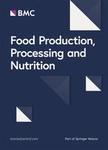Brewing and biochemical characterization of Camellia japonica petal wine with comprehensive discussion on metabolomics
作者机构:Molecular Biology and Tissue Culture LaboratoryDepartment of Tea ScienceUniversity of North BengalSiliguriDarjeelingWest Bengal 734013India Postgraduate Department of BotanyDarjeeling Government CollegeDarjeelingWest Bengal 734101India
出 版 物:《Food Production, Processing and Nutrition》 (食物生产加工与营养(英文))
年 卷 期:2022年第4卷第1期
页 面:366-382页
核心收录:
学科分类:1008[医学-中药学(可授医学、理学学位)] 0832[工学-食品科学与工程(可授工学、农学学位)] 1006[医学-中西医结合] 0703[理学-化学] 100602[医学-中西医结合临床] 10[医学]
主 题:Camellia Quinic acid GC-MS Fermentation Wine
摘 要:A novel wine has been developed from Camellia japonica’s petal by fermenting the decoction with Saccharomyces cerevisiae or brewer’s yeast. pH, brix, specific gravity and alcohol percentage were tested to study the physicochemical properties of the wine. Qualitative tests indicated presence of phenols such as flavonoids, coumarins;protein;glyco-sides;glycerin;terpenoids;steroids;and fatty acids in the wine. Total phenol content was found high in the decoction and in its fermented form as well. In vitro biological activities such as antioxidant activity, antidiabetic activity and lipid peroxidation inhibition power were assessed in samples. Furthermore, GC-MS analysis helped to detect volatiles present in the unfermented decoction and understand the effect of fermentation on its changing metabolome while column chromatography assisted the separation of solvent-based fractions. Notable outcomes from this study were detection of bioactive compound quinic acid in the decoction and a proposed pathway of its metabolic breakdown after fermentation. Results of this research revealed biochemical and physicochemical acceptability of this wine prepared from an underutilized flower.



